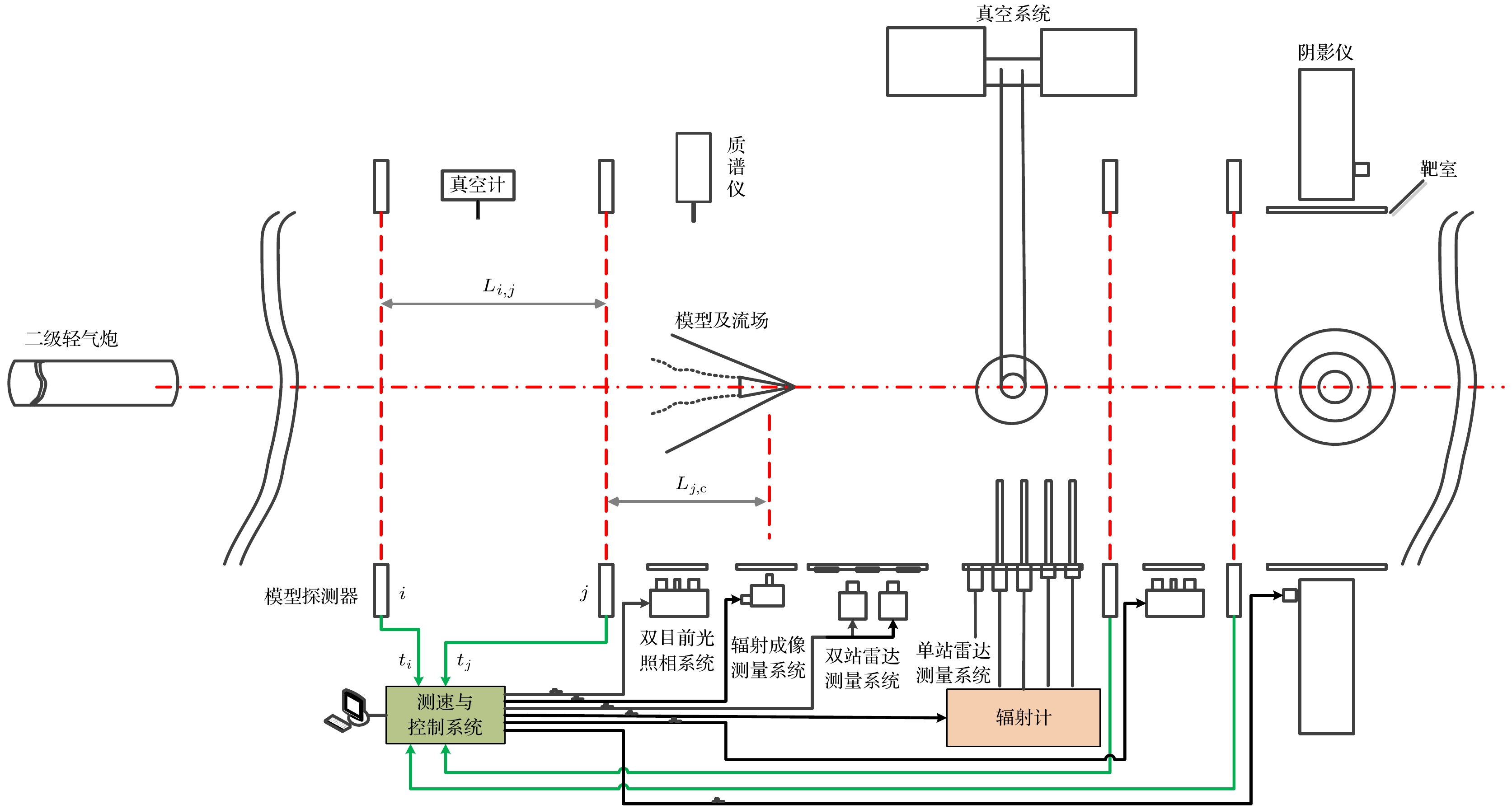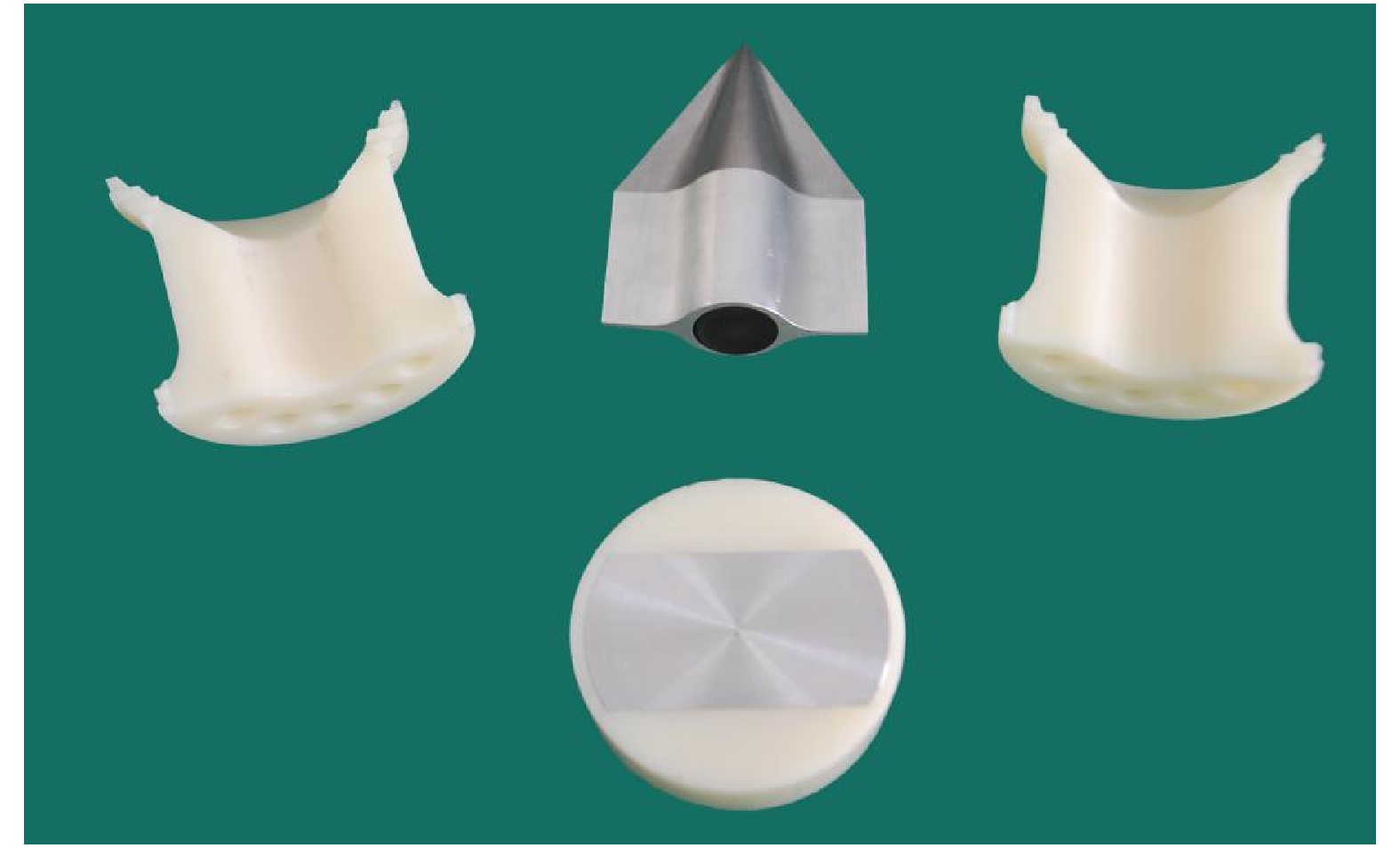-
According to the requirements for target detection and recognition of hypervelocity vehicles in near space, the simulation and measurement of corresponding electromagnetic scattering characteristics of non-uniform plasma generated by hypervelocity targets are conducted. A numerical calculation method with dynamic plasma parameters is developed and hypervelocity HTV2-like models launched by the ballistic ranges are used to simulate complex shape target flying at a hypervelocity velocity. The high-precision shadow imaging systems and radar measurement systems of the ballistic range are used to measure the model postures, the electromagnetic scattering characteristics of the whole targets and their flow fields in both C band and X band. The experimental measurement results of the radar cross section (RCS) of the models and their flow fields under different experimental conditions are obtained. The results show that the numerical simulation methods of unsteady high-temperature ionized air flow can be used to simulate the unsteady thermal chemical flow fields around the head and body of the simplified hypervelocity HTV2-like flight models. The electromagnetic scattering characteristics of the models and their plasma sheath differ by more than one order of magnitude under different experimental conditions. The total RCS of the model’s wake in the C band is much smaller than that of the model, and the total RCS of the model’s wake in the X band is significantly enhanced. The attitude angles of the models have great influence on their electromagnetic scattering characteristics and their RCSs with different attitude angles can differ by one order of magnitude. The electromagnetic scattering energy of the model in the C band is distributed mainly around the targets and their flow fields surrounding them. The X band electromagnetic scattering energy of the model is distributed mainly in the regions around the targets, surrounding flow fields and the wake flow fields. According to the experimental conditions of the ballistic range, the numerical simulation analyses of the electromagnetic scattering characteristics of the models and flow fields around them are carried out, and the maximum error between simulation and experimental results is less than 4 dB, verifying the effectiveness of the modeling methods of simulating electromagnetic scattering characteristics of non-uniform plasma coated targets.
-
Keywords:
- hypervelocity /
- model /
- plasma sheath /
- ballistic range
[1] Akey N D, Cross A E 1970 NASA-TN-D-5615 [1970-02-01]
[2] Dirsa E F 1960 Pro. IRE 48 703
 Google Scholar
Google Scholar
[3] Golden K E, Pridmore D C, Stewart G E 1970 NASA 19710011626 (Washington: NASA LANGLEY Research Center)
[4] Wood G E, Asmar S W, Rebold T A 1997 TDA Progress Report 42 131
[5] Bachynski M P, Gibbs B W 1970 NASA 19710011649 (Washington: NASA LANGLEY Research Center)
[6] Sotnikov V L, Leboeuf J N, Mudaliar S 2010 IEEE Trans. Plasma Sci. 38 2208
 Google Scholar
Google Scholar
[7] Usui H, Yamashita F, Matsumoto H 1999 Adv. Space Res. 24 1069
 Google Scholar
Google Scholar
[8] Mather D E, Pasqual J M, Sillence J P, Lewis P 2005 AIAA/CIRA 13th International Space Planes and Hypersonics Systems and Technology Capua, Italy, May 16–20, 2005 p3443
[9] 周超, 张小宽, 张晨新, 吴国成 2014 现代雷达 36 83
 Google Scholar
Google Scholar
Zhou C, Zhang X K, Zhang C X, Wu G C 2014 Modern Radar 36 83
 Google Scholar
Google Scholar
[10] 吴巍, 刘方, 钟建林, 王国宏 2019 电波科学学报 34 610
Wu W, Liu F, Zhong J L, Wang G H 2019 Chin. J. Radio. Sci. 34 610
[11] 金铭, 韦笑, 吴洋, 张羽淮, 余西龙 2015 物理学报 64 205205
 Google Scholar
Google Scholar
Jin M, Wei X, Wu Y, Zhang Y H, Yu X L 2015 Acta Phys. Sin. 64 205205
 Google Scholar
Google Scholar
[12] 马平, 石安华, 杨益兼, 于哲峰, 黄洁 2015 强激光与粒子束 27 073201
 Google Scholar
Google Scholar
Ma P, Shi A H, Yang Y J, Yu Z F, Huang J 2015 High Power Laser Part. Beams 27 073201
 Google Scholar
Google Scholar
[13] 马平, 石安华, 杨益兼, 于哲峰, 梁世昌, 黄洁 2017 物理学报 66 102401
 Google Scholar
Google Scholar
Ma P, Shi A H, Yang Y J, Yu Z F, Liang S C, Huang J 2017 Acta Phys. Sin. 66 102401
 Google Scholar
Google Scholar
[14] 邾继贵, 于之靖 2012 视觉测量原理与方法 (北京: 机械工业出版社) 第4678页
Zhu J G, Yu Z J 2012 Principles and Methods of Visual Measurements (Beijing: China Machine Press) pp46–78 (in Chinese)
[15] Sun H Y, Cui Z W, Wang J J, Han Y P, Shi P 2018 Phys. Plasmas 25 063514
 Google Scholar
Google Scholar
[16] Sun H Y, Wang J J, Han Y P, Cui Z W, Sun P, Shi X W, Zhao W J 2018 Int. J. Antennas Propag. 1 14
[17] 孙浩宇 2018 博士学位论文 (西安: 西安电子科技大学)
Sun H Y 2018 Ph. D. Dissertation (Xi’an: Xidian University) (in Chinese)
[18] 艾夏 2013 博士学位论文 (西安: 西安电子科技大学)
Ai X 2013 Ph. D. Dissertation (Xi’an: Xidian University) (in Chinese)
[19] 陈安涛 2019 博士学位论文 (西安: 西安电子科技大学)
Chen A T 2019 Ph. D. Dissertation (Xi’an: Xidian University) (in Chinese)
[20] 葛德彪, 闫玉波 2005 电磁波时域有限差分方法 (西安: 西安电子科技大学出版社) 第88—89页
Ge D B, Yan Y B 2005 Finite-Difference Time-Domain Method for Electromagnetic Waves (Xi’an: Xidian University Press) pp88–89 (in Chinese)
[21] Ai X, Han Y, Li C Y, Shi X W 2011 Prog. Electromagn. Res. Lett. 22 83
 Google Scholar
Google Scholar
[22] Ai X, Han Y, Chen Z, Shi X W 2011 Prog. Electromagn. Res. M. 18 143
 Google Scholar
Google Scholar
[23] Ai X, Tian Y, Han Y P, Shi X W, Li W T 2013 J. Quant. Spectrosc. Radiat Transfer 124 28
 Google Scholar
Google Scholar
[24] 陈伟, 郭立新, 李江挺, 淡荔 2017 物理学报 66 084102
 Google Scholar
Google Scholar
Chen W, Guo L X, Li J T, Dan L 2017 Acta Phys. Sin. 66 084102
 Google Scholar
Google Scholar
-
表 1 弹道靶高超声速球模型全目标RCS实验测量结果与数值计算结果对比
Table 1. Comparison between measurement and numerical results of the RCS of the ball models flying at hypervelocity.
实验状态 球模型及其等离子体鞘套套RCS/dBsm 尾迹RCS/dBsm 压力/kPa 速度/(km·s–1) 测量实验值 计算结果 实验测量值 计算结果 4.2 5.0 –31.40 –31.31 –52.10 –50.63 表 2 高超声速类HTV2模型C波段全目标RCS实验测量结果
Table 2. Measurement results of the C band full target RCS of the simplified HTV2 models flying at hypervelocity.
实验状态 模型姿态 高超声速类HTV2模型全目标RCS实测结果/dBsm 速度/(km·s–1) 压力/kPa 俯仰角
/(°)偏航角
/(°)滚转角
/(°)模型全目标
总RCS本体及绕流场RCS 尾迹RCS 5.0 7.6 22.43 5.18 103.65 5.91 5.90 –18.83 5.0 8.8 –1.85 14.79 –107.27 –4.19 –4.27 –21.57 5.0 10.4 –7.15 –2.10 69.40 –2.61 –2.72 –18.75 5.0 15.3 6.02 –10.1 –109.07 1.90 1.87 –19.79 表 3 高超声速类HTV2模型X波段全目标RCS实验测量结果
Table 3. Measurement results of the X band full target RCS of the simplified HTV2 models flying at hypervelocity.
实验状态 模型姿态 高超声速类HTV2模型全目标RCS
实测结果/dBsm速度
/(km·s–1)压力
/kPa俯仰角/(°) 偏航角
/(°)滚转角
/(°)模型全目标
总RCS本体及绕流场RCS 尾迹RCS 4.0 8.5 –17.00 23.00 6.80 –8.75 –8.76 –35.56 5.0 6.6 7.50 –11.00 108.28 1.05 1.05 –30.70 5.0 8.2 18.93 17.11 109.95 –2.92 –3.44 –12.43 5.0 11.6 4.03 –3.25 107.73 –3.63 –3.94 –15.23 5.0 14.8 –7.00 9.10 70.93 –5.99 –9.36 –8.68 表 4 高超声速类HTV2模型不同波段RCS的FDTD方法数值模拟结果与弹道靶实验测量结果的对比
Table 4. Various bands RCS comparisons between FDTD simulations and experiment results of the simplified HTV2 models flying at hypervelocity.
测量波段 实验状态 姿态角/(°) 模型及等离子体鞘套总RCS 压力
/kPa速度/(km·s–1) 俯仰角 偏航角 滚转角 测量/dBsm 计算/dBsm 误差/dB X 8.2 5.0 18.93 17.11 109.95 –3.30 –1.51 1.79 C 10.4 5.0 –7.15 –2.10 69.4 0.73 3.14 2.41 X 11.6 5.0 4.03 –3.25 107.73 –3.94 –5.20 1.26 X 14.8 5.0 –7.00 9.10 70.93 –9.26 –6.01 3.35 -
[1] Akey N D, Cross A E 1970 NASA-TN-D-5615 [1970-02-01]
[2] Dirsa E F 1960 Pro. IRE 48 703
 Google Scholar
Google Scholar
[3] Golden K E, Pridmore D C, Stewart G E 1970 NASA 19710011626 (Washington: NASA LANGLEY Research Center)
[4] Wood G E, Asmar S W, Rebold T A 1997 TDA Progress Report 42 131
[5] Bachynski M P, Gibbs B W 1970 NASA 19710011649 (Washington: NASA LANGLEY Research Center)
[6] Sotnikov V L, Leboeuf J N, Mudaliar S 2010 IEEE Trans. Plasma Sci. 38 2208
 Google Scholar
Google Scholar
[7] Usui H, Yamashita F, Matsumoto H 1999 Adv. Space Res. 24 1069
 Google Scholar
Google Scholar
[8] Mather D E, Pasqual J M, Sillence J P, Lewis P 2005 AIAA/CIRA 13th International Space Planes and Hypersonics Systems and Technology Capua, Italy, May 16–20, 2005 p3443
[9] 周超, 张小宽, 张晨新, 吴国成 2014 现代雷达 36 83
 Google Scholar
Google Scholar
Zhou C, Zhang X K, Zhang C X, Wu G C 2014 Modern Radar 36 83
 Google Scholar
Google Scholar
[10] 吴巍, 刘方, 钟建林, 王国宏 2019 电波科学学报 34 610
Wu W, Liu F, Zhong J L, Wang G H 2019 Chin. J. Radio. Sci. 34 610
[11] 金铭, 韦笑, 吴洋, 张羽淮, 余西龙 2015 物理学报 64 205205
 Google Scholar
Google Scholar
Jin M, Wei X, Wu Y, Zhang Y H, Yu X L 2015 Acta Phys. Sin. 64 205205
 Google Scholar
Google Scholar
[12] 马平, 石安华, 杨益兼, 于哲峰, 黄洁 2015 强激光与粒子束 27 073201
 Google Scholar
Google Scholar
Ma P, Shi A H, Yang Y J, Yu Z F, Huang J 2015 High Power Laser Part. Beams 27 073201
 Google Scholar
Google Scholar
[13] 马平, 石安华, 杨益兼, 于哲峰, 梁世昌, 黄洁 2017 物理学报 66 102401
 Google Scholar
Google Scholar
Ma P, Shi A H, Yang Y J, Yu Z F, Liang S C, Huang J 2017 Acta Phys. Sin. 66 102401
 Google Scholar
Google Scholar
[14] 邾继贵, 于之靖 2012 视觉测量原理与方法 (北京: 机械工业出版社) 第4678页
Zhu J G, Yu Z J 2012 Principles and Methods of Visual Measurements (Beijing: China Machine Press) pp46–78 (in Chinese)
[15] Sun H Y, Cui Z W, Wang J J, Han Y P, Shi P 2018 Phys. Plasmas 25 063514
 Google Scholar
Google Scholar
[16] Sun H Y, Wang J J, Han Y P, Cui Z W, Sun P, Shi X W, Zhao W J 2018 Int. J. Antennas Propag. 1 14
[17] 孙浩宇 2018 博士学位论文 (西安: 西安电子科技大学)
Sun H Y 2018 Ph. D. Dissertation (Xi’an: Xidian University) (in Chinese)
[18] 艾夏 2013 博士学位论文 (西安: 西安电子科技大学)
Ai X 2013 Ph. D. Dissertation (Xi’an: Xidian University) (in Chinese)
[19] 陈安涛 2019 博士学位论文 (西安: 西安电子科技大学)
Chen A T 2019 Ph. D. Dissertation (Xi’an: Xidian University) (in Chinese)
[20] 葛德彪, 闫玉波 2005 电磁波时域有限差分方法 (西安: 西安电子科技大学出版社) 第88—89页
Ge D B, Yan Y B 2005 Finite-Difference Time-Domain Method for Electromagnetic Waves (Xi’an: Xidian University Press) pp88–89 (in Chinese)
[21] Ai X, Han Y, Li C Y, Shi X W 2011 Prog. Electromagn. Res. Lett. 22 83
 Google Scholar
Google Scholar
[22] Ai X, Han Y, Chen Z, Shi X W 2011 Prog. Electromagn. Res. M. 18 143
 Google Scholar
Google Scholar
[23] Ai X, Tian Y, Han Y P, Shi X W, Li W T 2013 J. Quant. Spectrosc. Radiat Transfer 124 28
 Google Scholar
Google Scholar
[24] 陈伟, 郭立新, 李江挺, 淡荔 2017 物理学报 66 084102
 Google Scholar
Google Scholar
Chen W, Guo L X, Li J T, Dan L 2017 Acta Phys. Sin. 66 084102
 Google Scholar
Google Scholar
Catalog
Metrics
- Abstract views: 3713
- PDF Downloads: 66
- Cited By: 0















 DownLoad:
DownLoad:











